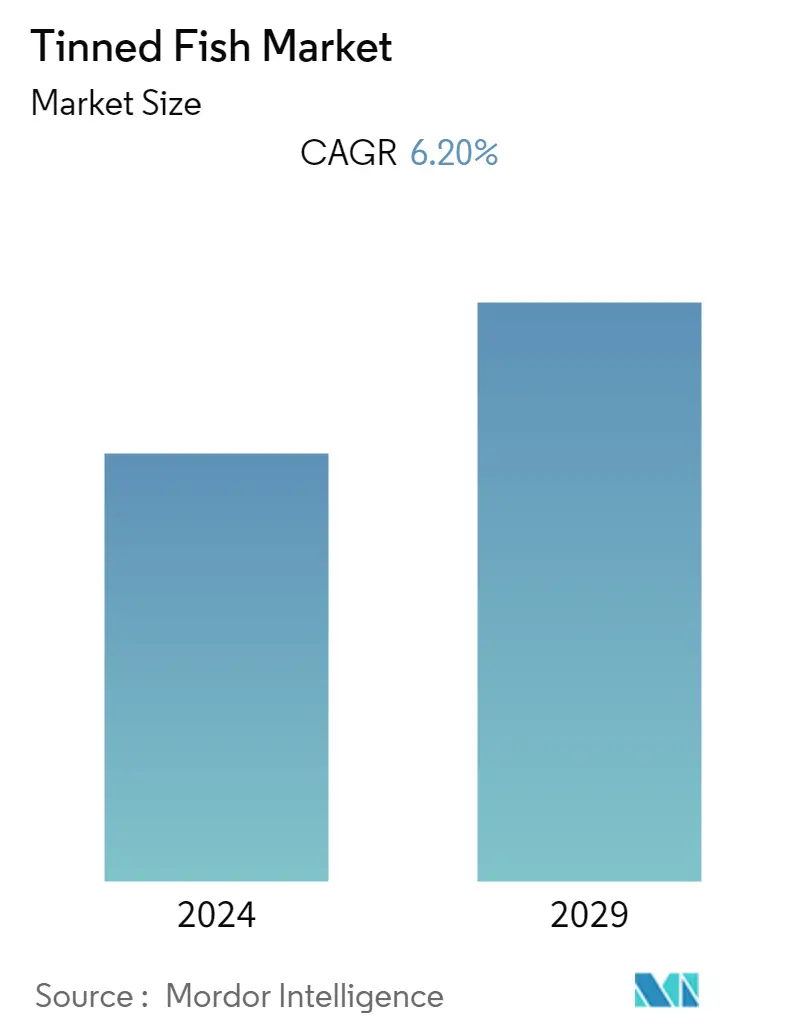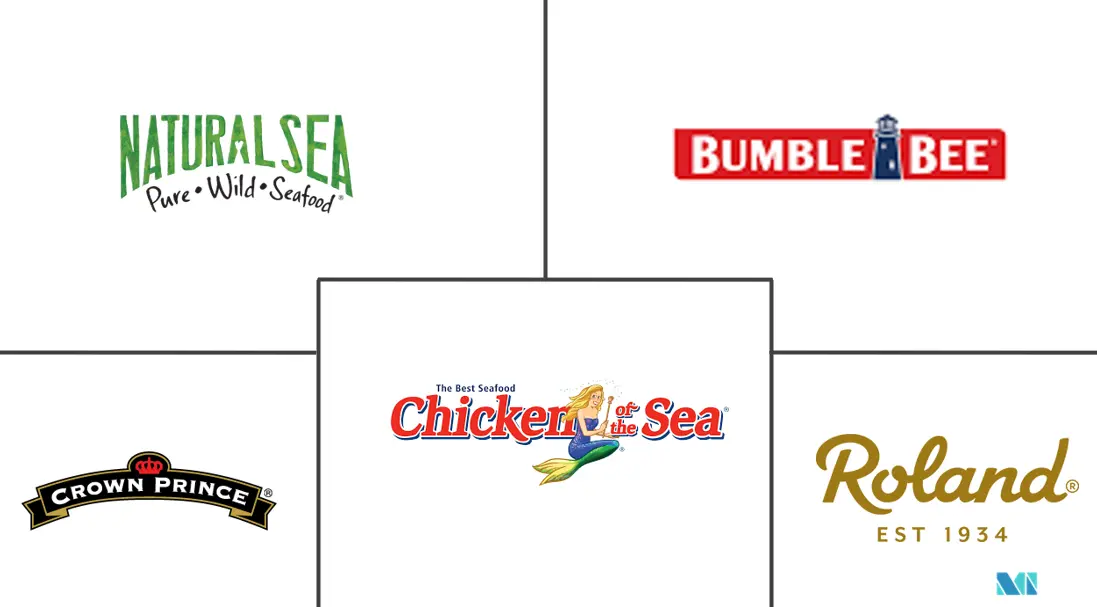Market Size of Tinned Fish Industry

| Study Period | 2019 - 2029 |
| Base Year For Estimation | 2023 |
| CAGR | 6.20 % |
| Fastest Growing Market | Asia-Pacific |
| Largest Market | Europe |
| Market Concentration | Low |
Major Players
*Disclaimer: Major Players sorted in no particular order |
Tinned Fish Market Analysis
Tinned Fish Market is projected to register a CAGR of 6.2% during the forecast period, 2022-2027.
The growing demand for seafood coupled due to its healthy attributes like the presence of superior quality proteins, essential fatty acids, and macro and micronutrients is driving the global tinned fish market. Fish represents a rich source of nutrients necessary for good health. In addition, the expanding trend of consuming convenience foods due to busy lifestyles is influencing consumer inclination towards processed food such as tinned fish. Further, the improved distribution infrastructure and fish processing methods are driving the growth of the tinned fish market across the globe. Therefore, new product introductions, expanding distribution channels, and improvements in canning techniques are anticipated to boost market expansion during the projection period.
Packaging is a crucial factor in producing high-quality tinned fish as it aids in the shelf-life and safety of any packaged food. Consumer product usage is anticipated to expand with the introduction of RFID tags in packaging to improve product traceability and aggregation, which will support market expansion. For instance, in March 2021, Thai Union Frozen products SPACE-F announced Foods Tech Accelerator and Incubator Program that allow food processing at a faster pace and preserve the quality of its food.
However, because the quality of fish is influenced by species, the time of year it is harvested, how it is handled, and how it is processed. Thus, appropriate food additives are added to preserve the shelf life, nutritional value, texture, and flavor of tinned fish. As a result, the addition of food additives has the potential to hinder the market's growth during the forecast period.
Tinned Fish Industry Segmentation
Tinned fish is processed fish, sealed in an airtight can, and preserved in salt and water, or oil. The global tinned fish market is segmented by type, distribution channel, and geography. By type, the market is segmented into mackerel, salmon, sardines, tuna, and others. Based on the distribution channel, the market is segmented into supermarkets/hypermarkets, convenience stores, online retail stores, and other distribution channels. It provides an analysis of emerging and established economies across the world, comprising North America, Europe, South America, Asia-Pacific, and Middle East and Africa. For each segment, the market sizing and forecasts have been done on the basis of value (in USD million).
| By Type | |
| Mackerel | |
| Salmon | |
| Sardines | |
| Tuna | |
| Other |
| By Distibution Channel | |
| Supermarkets and Hypermarkets | |
| Convenience Stores | |
| Online Retail Channels | |
| Other Distribution Channels |
| By Geography | |||||||||
| |||||||||
| |||||||||
| |||||||||
| |||||||||
|
Tinned Fish Market Size Summary
The tinned fish market is experiencing significant growth, driven by the increasing demand for seafood due to its health benefits, including high-quality proteins and essential fatty acids. The trend towards convenience foods, fueled by busy lifestyles, is also contributing to the market's expansion, as consumers seek easy-to-prepare and nutritious meal options. Advances in distribution infrastructure and fish processing techniques are further supporting market growth. The introduction of innovative packaging solutions, such as RFID tags for improved traceability, is expected to enhance product quality and safety, thereby boosting consumer confidence and market demand. However, the reliance on food additives to maintain the quality and shelf life of tinned fish may pose challenges to market growth.
Europe leads the global tinned fish market, with a growing preference for protein-rich convenience foods and sustainable seafood products. Countries like Germany, the United Kingdom, Portugal, and France are at the forefront of this trend, with increasing consumer spending on sustainable tinned fish. The market is highly competitive, with major companies like Bumble Bee Foods, Natural Sea, and Chicken of the Sea International focusing on strategic growth initiatives, including product launches and partnerships. These efforts are aimed at expanding their presence in untapped markets and enhancing product offerings. The introduction of new packaging systems and the launch of sustainably sourced tinned fish products are examples of how companies are innovating to meet consumer demands and drive market growth.
Tinned Fish Market Size - Table of Contents
-
1. MARKET DYNAMICS
-
1.1 Market Drivers
-
1.2 Market Restraints
-
1.3 Porter's Five Force Analysis
-
1.3.1 Threat of New Entrants
-
1.3.2 Bargaining Power of Buyers/Consumers
-
1.3.3 Bargaining Power of Suppliers
-
1.3.4 Threat of Substitute Products
-
1.3.5 Intensity of Competitive Rivalry
-
-
-
2. MARKET SEGMENTATION
-
2.1 By Type
-
2.1.1 Mackerel
-
2.1.2 Salmon
-
2.1.3 Sardines
-
2.1.4 Tuna
-
2.1.5 Other
-
-
2.2 By Distibution Channel
-
2.2.1 Supermarkets and Hypermarkets
-
2.2.2 Convenience Stores
-
2.2.3 Online Retail Channels
-
2.2.4 Other Distribution Channels
-
-
2.3 By Geography
-
2.3.1 North America
-
2.3.1.1 United States
-
2.3.1.2 Canada
-
2.3.1.3 Mexico
-
2.3.1.4 Rest of North America
-
-
2.3.2 Europe
-
2.3.2.1 United Kingdom
-
2.3.2.2 Germany
-
2.3.2.3 Spain
-
2.3.2.4 France
-
2.3.2.5 Italy
-
2.3.2.6 Russia
-
2.3.2.7 Rest of Europe
-
-
2.3.3 Asia-Pacific
-
2.3.3.1 China
-
2.3.3.2 Japan
-
2.3.3.3 India
-
2.3.3.4 Australia
-
2.3.3.5 Rest of Asia-Pacific
-
-
2.3.4 South America
-
2.3.4.1 Brazil
-
2.3.4.2 Argentina
-
2.3.4.3 Rest of South America
-
-
2.3.5 Middle East & Africa
-
2.3.5.1 Saudi Arabia
-
2.3.5.2 South Africa
-
2.3.5.3 Rest of Middle East & Africa
-
-
-
Tinned Fish Market Size FAQs
What is the current Tinned Fish Market size?
The Tinned Fish Market is projected to register a CAGR of 6.20% during the forecast period (2024-2029)
Who are the key players in Tinned Fish Market?
Natural Sea, Crown Prince, Inc., Roland Foods, LLC., Bumble Bee Foods, LLC. and Chicken of the Sea are the major companies operating in the Tinned Fish Market.

